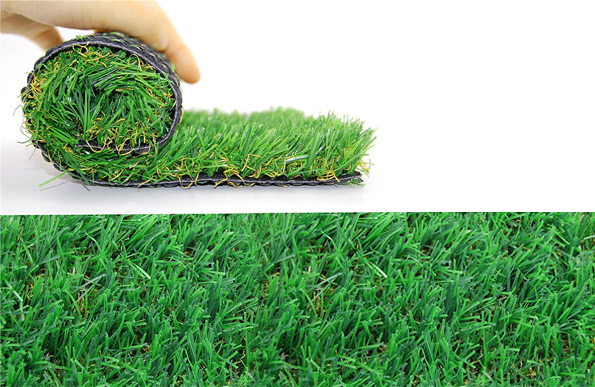Composition requirements for artificial landscape grass
The raw materials of
artificial landscape grass are mostly polyethylene and polypropylene. The leaves are colored green imitating natural grass, and UV absorbers need to be added.
Polyethylene: It feels softer, and its appearance and sports performance are closer to natural grass, which is widely accepted by users. It is the most widely used artificial landscape grass fiber raw material in the market.
Polypropylene: Grass fibers are relatively hard and are generally suitable for tennis courts, playgrounds, running tracks, or decorations.
Nylon: It is the earliest artificial landscape grass fiber raw material and belongs to the first generation of artificial landscape grass fiber.
The material structure of artificial landscape grass
Artificial landscape grass consists of three layers of material. The base layer is composed of a rammed soil layer, a crushed stone layer, and an asphalt or concrete layer. The base layer is required to be solid, non-deformable, smooth, and impermeable, which is a general concrete site. Because the hockey field has a large area, the base layer must be properly treated during construction to prevent subsidence. If the concrete layer is laid, expansion joints should be cut after the concrete is cured to prevent thermal expansion, deformation, and cracks.
On top of the base layer is a cushioning layer, usually rubber or foam. The rubber is moderately elastic, with a thickness of 3~5mm. The cost of using foam plastic is low, but the elasticity is poor, and the thickness is 5-10 mm. If it is too thick, the lawn will be too soft and easy to dent; if it is too thin, it will lack elasticity and will not have a cushioning effect. The buffer layer should be firmly pasted on the base layer, usually with white latex or all-purpose glue.
The third layer, also the surface layer, is the sod layer. According to the surface shape of the manufacturer, there are fluffy turf, ring-shaped curly nylon turf, leaf-shaped polypropylene fiber turf, nylon woven permeable turf, etc. This layer must also be glued to the rubber or styrofoam board with latex. During construction, the glue must be fully applied, and pressed tightly in sequence, without wrinkling.
The difference between natural grass and artificial landscape grass is as follows
1. Climatic condition requirements
Natural grass: The climate has a great impact on natural grass. Many countries or regions have extremely harsh climates, such as hot Africa and severe cold in Eastern Europe. Natural grass is difficult to grow.
Artificial landscape grass : Contrary to natural grass, artificial landscape grass can be used no matter how bad the weather conditions are, without any influence. This is why natural grass is gradually replaced by artificial landscape grass in extreme climate areas.
2. Use time and lifespan
Natural grass: If the natural grass is well maintained, it can be used for a long time, but if it is not well maintained, it will also lead to the death of the lawn, and the service life and duration cannot be guaranteed.
Artificial landscape grass: The raw material is PE (polyethylene), which has very good wear resistance and is very suitable for sports grounds. It has been tested by experimental data, long-term practical experience, and professional institutions. It can be used around the clock and is not limited by the duration of use. The life span of general artificial landscape grass is about 8 years.
3. Requirements for post-maintenance
Natural grass: We all know that the natural grass of the football field is maintained by a special person. After each game, professional maintenance is required, including (replanting the missing lawn, mowing the lawn), watering and fertilizing when there is no game, Pruning, insecticide, and other maintenance work, the post-maintenance work is very cumbersome.
Artificial landscape grass: The tedious maintenance work of natural grass can be saved in the later stage, and only some regular cleaning and some simple maintenance are required.
4. Basic requirements
Natural grass: Natural grass cannot be planted in all places, and the three conditions of soil, watering, and fertilization are quite lacking.
Artificial landscape grass: The foundation is not affected by the place. It can be laid on concrete or hard soil. It will not be affected by many factors like natural grass.
5. Requirements for sports performance
Natural Grass: Natural grass is characterized by its softness, which will not cause abrasions to the athlete's body. Natural grass has better sports performance and will not affect the direction and trajectory of the ball.
Artificial landscape grass: Made of acrylic fiber material, it has excellent anti-skid performance and improves friction.
